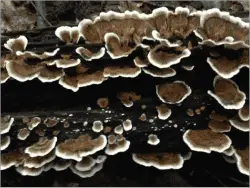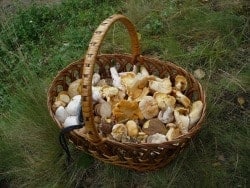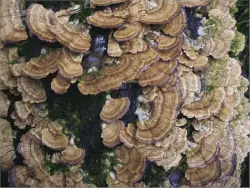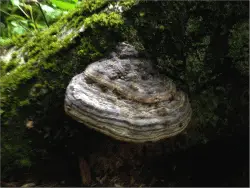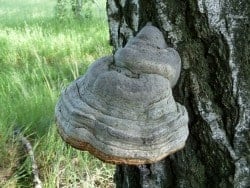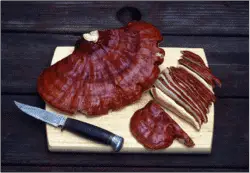As punk, dried Polypores can be lit and hold the ember very well. It is for this reason that their benefits begin with the first spark of the fire, which will stay aglow easily on good punk. Tinder Polypore, Artist Conk (Ganoderma applanatum), and others have a felty interior when the hard fruiting bodies are broken open. These mushrooms are also called conks, shelf mushrooms, and bracket fungi and are perennial, developing layer upon layer, year after year. This type of mushroom is very good for tinder. The felt can be teased with your knife. There are other types of shelf mushrooms that are not perennial. Often, they will be more moist and fleshing, or otherwise maybe not the best for tinder… perhaps because of their texture. Also, there are Polypores that aren’t shelf mushrooms.
It is especially the Polypores that are of interest to the bushcrafter and survivalist. They are a pretty safe group for edibles. Many are not considered edible because of toughness or taste, but the majority of poisoning is relatively mild. Of course, many well-known “choice edibles” and some of the most sought after mushroom delicacies are Polypores. They have medicinal uses. Many of the most important herbal medicines come from Polypores. They can be used to start fire. Because they keep lit well and burn slow they can also be used to carry fire (potentially very useful without matches or a lighter on hand), and can also be burned for insect repellant. The dried fruit bodies, or slices of them, can be used to maintain an ember when not feeding wood to the fire. Polypores can also be used to make torches. They can be made into charcoal. They can be pounded into felt (another trait the Tinder Polypore is particularly known for). They are great for storing fish hooks. And I am sure there are countless other uses.
SKIP AHEAD
Edible Mushrooms
I myself have eaten massive amounts of mushrooms, especially Polypores like Chicken of the Woods (Laetiporus spp.), Hen of the Woods (Grifola frondosa, Maitake, Sheep’s Head, etc.), and others that grow very large and are delicious. Many times I have eaten more than one meal a day that consisted primarily of mushrooms. I have often felt very revitalized when doing so, particularly during Morel (Morchella spp.) season when eating lots of Dryad’s Saddle (Polyporus squamosus), Morels, and wild vegetables. Mushrooms are very nutritious foods. Since ancient times they have been revered for their rejuvenating properties.
The all too well known problem with mushrooms as edibles is that some are deadly. Coupled with the fact that mushrooms in general are difficult to identify, eating mushrooms can clearly be risky. Do your research before starving to death so that you can be certain to take the time to seek out knowledgeable people as well as good books. There are many excellent mushroom websites.
Mushrooms can be dried. Though, it is a funny trick of nature that they tend to grow when there is more humidity and can be difficult to dry. Those in the Rocky Mountains will have a much easier time of it than I do down in the Delaware River Valley between New York and Pennsylvania. For off-grid sites, consider a solar dehydrator, such as passive solar using glass to trap heat. For sites with electricity consider one of the many commercially manufactured dehydrators, or make one with a simple heating unit such as a light bulb.
Medicinal Mushrooms
Indeed, primary traits among the medicinal mushrooms are antimicrobial and immune-boosting properties. Polypores in particular, like Turkey Tail (Trametes versicolor) and Agarikon (Fomitopsis officinalis), are known for benefiting immunity and fighting off pathogens. They are used for lung ailments, respiratory infections, systemic infections, cancer, and even auto-immune diseases. As in the case with Otzi, ancient people all over the world have probably recognized the medicinal benefits of mushrooms. Today they remain primary ingredients in herbal medicine. Many cultures have long-held reverence for medicinal mushrooms. China, for instance, has an extensive and ancient lore surrounding Ganoderma spp., called Lingzi, which means “Longevity Mushroom” or “Spiritual Mushroom” just as the Japanese name, Reishi, does. For a well-researched reference on many species of medicinal mushrooms see The Fungal Pharmacy by Robert Rogers.
While Reishi is too tough and strong tasting to be eaten (rather, it is decocted into a “tea” or broth), many medicinals are good food. Maitake (Grifola frondosa) is another name that seems to reflect a long-found reverence. In Japanese it means “Dancing Mushroom”, which some say is because it was worth so much (so revered were such medicinal mushrooms) in ancient Japan that you would dance for joy upon finding one. Or, perhaps if you were suffering from a life threatening illness that Maitake was known to cure you would have even more reason to dance. Locally, Grifola is one of the most commonly picked mushrooms, known as Sheep’s Head or Ram’s Head – largely an Appalachian name. American field guides and grocery stores (this one is also cultivated) usually call it Hen-of-the-Woods. It is so abundant in certain Oak forests that people will often eat more than their fill and still have plenty to dry, can, or freeze.
Mushrooms even have antifungal properties. If this seems strange, consider that you are protected by pathogens by your skin. Fungus has no such barrier, but must still protect itself against pathogens… including fungus! Fungus tends to prefer dark, damp, dirty areas where other fungus also likes to grow. Much of the immune-boosting potential of mushrooms is explained in this way.
Many mushrooms, especially certain Polypores and the Luminescent Panellus (Panellus stipticus) can be used to stop bleeding. The species name stipticus is from styptic, meaning that it is used to stop bleeding. And yes, the common name is because it glows in the dark- at least the North American variety.
Fire-Starting with Fungus
Transferring a “coal” from bow or hand drill methods is simply done by contacting the mushroom with the ember so that it keeps lit. One might even use larger flat polypores underneath the fireboard so that the hot wood dust falls directly on the mushroom.
Polypores are like punk, meaning that they stay lit easy. Punky wood (dry and rotten) might very well stay lit for hours from only a spark or ember, but generally wood requires sufficient heat to keep burning or it goes out. Polypores can stay lit for many hours, often slowly burning from just a small ember until all the mushroom is burned up. This has several uses. Such as in primitive times, lit Polypores can be bound in leaves and bark so that the fire could be carried to the next spot. I have also maintained embers in the firepit by setting in them a piece of Polypore during times when I did not desire to build up the fire by adding more wood. Obviously, the standard rule is to keep watch on a fire at all times, but we are talking survival here. Perhaps, you are lost in the woods with no fire-starting implements and need to spend the day hunting, fishing, or gathering mushrooms. You certainly don’t want to lose your fire, but you don’t want to build it up either right before leaving. It could be much safer to feed the embers with mushrooms than to pile on firewood.
Also Read: How to Start a Fire With Your EDC Knife and a Shoelace
Mushrooms don’t have the tendency to burst into flame, even though they stay lit well. In order to produce flame, hot pitch can be poured on the Polypore and then lit to produce a torch. Alternately, clumps of pitch can be set or stuck (depending on consistency) on a Polypore and then lit. The pitch will melt down into the mushroom and this makes good fuel.
Polypores can also be made into charcoal in the same manner as making char cloth. I have used the leathery Polypores, like Turkey Tail, as well as slices of thicker species like Tinder Polypore and Reishi. I usually use tins, such as old Altoids tins, to fill with the mushrooms and then place on the hot coals until smoking ceases. Then remove, let cool, and add to your tinder box for later fire-starting.
Fiber from Polypores
At the New Jersey Mycological Association’s yearly Fungus Fest they set up a paper-making station. Violet Tooth Polypores (Trichaptum biforme) and other similar mushrooms are blended in water in order to produce a fibrous mush that is strained, pressed, and dried to produce a sturdy craft paper. Violet Tooth Polypores work well for fiber extraction because they are thin, like the well-known medicinal Turkey Tail and other mushrooms that comprise the “leathery” group of Polypores.
Taking Care of Tools with Polypores
Apparently Birch Polypore can be used for stropping. An alternate name commonly cited for the Birch Polypore (Piptoporus betulinus) is Razor Strop. I have never tried it, but the dried fruiting bodies certainly seem to be the correct consistency (usually leather is used for stropping).


